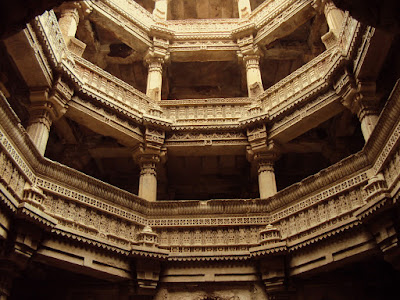 |
| Stepwells are used to collect rain water during the monsoons. Adalaj step well, Gujaratwww.myhinduethics.com |
 |
| Adalaj step well, Gujarat, India.en.wikipedia.org |
 |
| Adalaj step well, Gujarat, India.en.wikipedia.org/ |
 |
| Adalaj Ni -step well, Gujarat Vavwww.desigujju.com |
 |
| Adalaj step well, Gujarat, India.en.wikipedia.org |
 |
| Adalaj step-well, near Ahmedabad, Gujarat, India.en.wikipedia.org |
 |
| Ornate stone pillars supporting the gallery below the ground. Adalaj step well, Gujarat, India.en.wikipedia.org |
 |
| Intricate carving in the well structure- symbolic pot of life.en.wikipedia.org |
 |
| looking up the well. Adalaj step well, Gujarat, India.en.wikipedia.org |
Adalaj step well was built in 1498 by a Muslim ruler one Mohahamed Bagada for Queen Rani Roopha, wife of Rana Veer Singh of Vaghela dynasty, a local ruler who was killed in a battle by the Muslim ruler. Attracted by the ravishing beauty of the Hindu queen, he made a marriage proposal to her. At last the bewitching queen agreed on condition that he must complete the unfinished step well project undertaken by her slain husband. Accordingly ruler Bagada proceeded and finished the work. Upon completion of the step well, the smart, honorable queen ceremoniously went round the well three times (a custom followed by the Hindus) and jumped into the well, ending her youthful life. Literally taken aback, Bagada did not demolish the decorative well and kept it in memory of Rani (queen) Roopha.
Ref:
https://en.wikipedia.org/wiki/Adalaj_Stepwell
http://www.gujarattourism.com/destination/details/6/32









